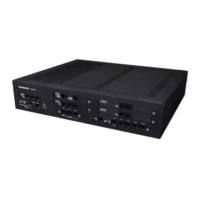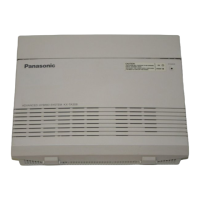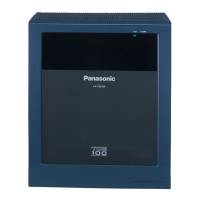In this example, only PBX-1 has an extension beginning with "8" assigned (for the VPS). In the Flexible
Numbering Plan for PBX-2
and PBX-3, "1", "2", and "3" must be set as "Extension Numbers", and "8" must be
set as an "Other PBX Extension Number (TIE)".
PC Programming Manual References
3.48 [1-3] Option—
New Card Installation—ISDN Standard Mode for PRI23 Card
5.19 [3-7-2] VM(DPT) Group—Unit Settings—Centralized VM Unit Setting
11.1 [9-1] TIE Table—Enhanced QSIG
11.2 [9-2] Network Data Transmission
→ Network MSW Data Transmission for Centralized VM Feature—Data Re-transmission : Repeat
Counter
→ Network MSW Data Transmission for Centralized VM Feature—Data Re-transmission : Repeat
Timer
13.1 [11-1] Main—Maintenance
→
Error Log for Centralized VM—Network MSW Transmission (Counter)
→ Error Log for Centralized VM—Network MSW Transmission (Buffer)
Feature Manual References
13.1.15 PRIVATE NETWORK FEATURES
19.1.4 Voice Mail DPT (Digital) Integration
13.1.17 Private Network Features—NDSS (Network Direct Station
Selection)
Description
When PBXs are networked using ISDN or V-IPGW/IP-GW
cards, it is possible to assign flexible buttons as
Network Direct Station Selection (NDSS) buttons. These buttons are used to monitor the status of extensions
connected to up to seven other PBXs in the network, and to make or transfer calls to those extensions with
one touch, like normal DSS buttons. This allows operator functions to be centralized even when there are
offices in remote locations.
NDSS buttons show the status of the monitored extension as follows:
Light pattern Status
Off The monitored extension is idle.
Red on The monitored extension is busy or has set DND for CO line calls.
264 Feature Manual Document Version 2013-05
13.1.17 Private Network Features—NDSS (Network Direct Station Selection)

